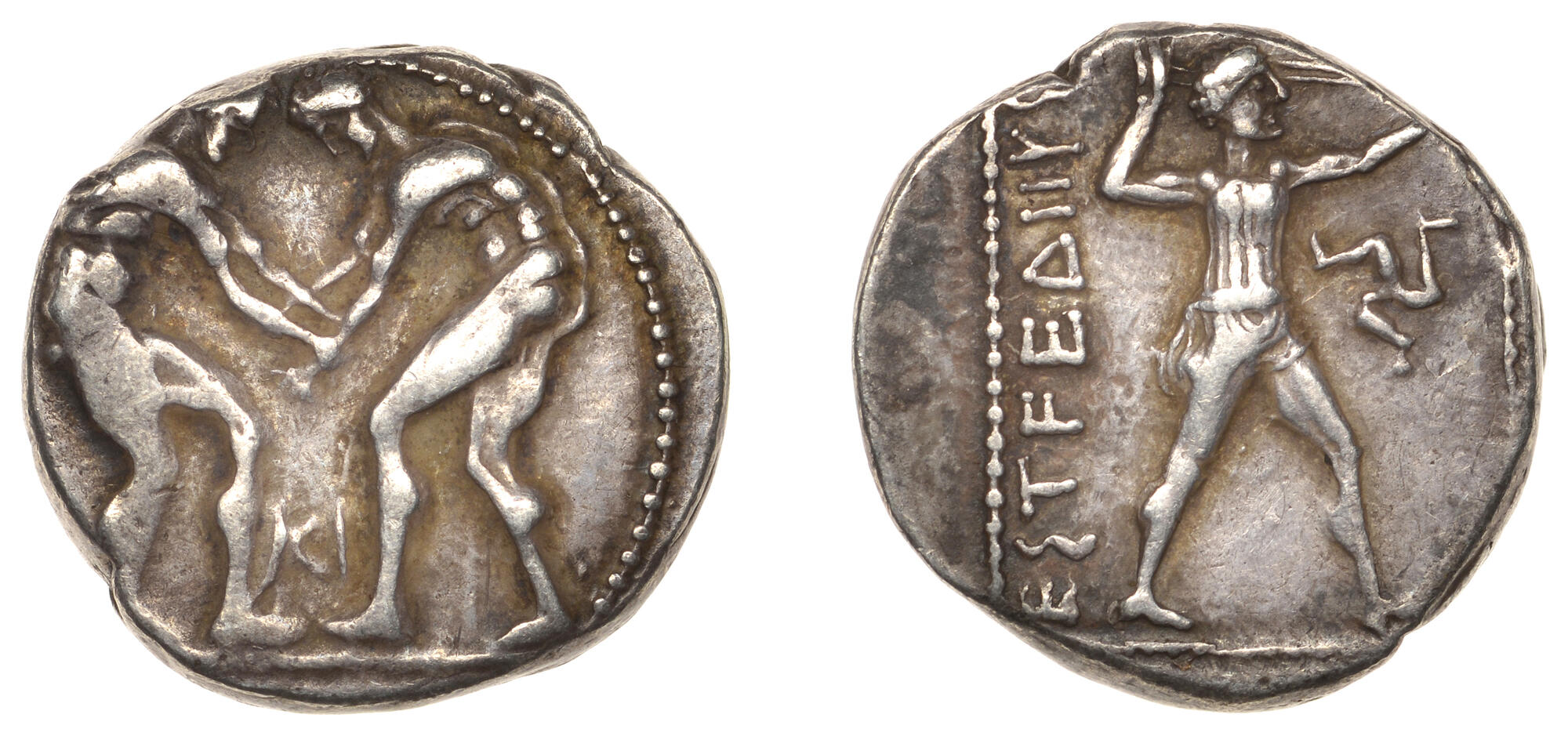Aspendus, silver, double sigloi (variety KI) (370-333 BCE) Callataÿ
From SILVER
370 BCE - 333 BCE Silver 1,053 kg
Description
| ObverseInscription or printing placed on the obverse.: | Two wrestlers grappling, ki between, |
| ReverseInscription or printing placed on the reverse.: | EΣTFEΔIIYΣ Slinger in throwing stance right, triskeles and eagle in right field |
Mint and issuing power
| MintIdentifies the place of manufacture or issue of a numismatic object.: | Aspendus | Ancient regionAncient region.: | Pamphylia | Modern countryModern country: Turkey | AuthorityIdentifies the issuing power. The authority can be "pretended" when the name or the portrait of X is on the coin but he/she was not the issuing power. It can also be "uncertain" when there is no mention of X on the coin but he/she was the issuing power according to the historical sources: | Persian Empire |
Chronology
| FromIdentifies the initial date in a range assigned in a numismatic context. | 370 BCE | toIdentifies the final date in a range assigned in a numismatic context.. | 333 BCE | PeriodTime period of the numismatic object.: Classical 480-323 BC |
Physical description
| MetalThe physical material (usually metal) from which an object is made.: | Silver |
Median weightMedian of the weights of numismatic objects (in grams). in grams | 10.95 | DenominationTerm indicating the value of a numismatic object. Examples: tetradrachm, chalkous, denarius.: | double siglos |
StandardStandard.: | Persian |
Image

S1642 Aspendos KI.jpg [1]
References
| Die study referencePublication of the study: | Callataÿ 20161Callataÿ 2016, p. 68-70 | ||
| Coin series referenceReference to coin series study: | Sear II2Sear II, n° 5390-5393, SNG von Aulock Pamphylien3SNG von Aulock Pamphylien, n° 4557, SNG France 34SNG France 3, n° 104 | ||
| Coin series web referenceCoin series web references: | |||
Obverse dies distribution
| FrequencyFrequency of specimen in distribution. ᵖ | Number of obversesNumber of obverse dies. ᵖ (o) | % (o) | Number of coinsNumber of coins. (n) | % (n) | Die nameName(s) of the die(s). |
| 2 | 2 | 40 | 4 | 2.82 | 4, 5 |
| 5 | 1 | 20 | 5 | 3.52 | 3 |
| 7 | 1 | 20 | 7 | 4.93 | 2 |
| 126 | 1 | 20 | 126 | 88.73 | 1 |
| Total | 5 of 5 | 100 | 142 of 142 | 100 |
Reverse dies distribution
no distribution is available
Quantification
| Number of obversesNumber of obverse dies. ᵖ (o) | 5 | Number of singletons (o1)The number of singleton coins. ᵖ | |
| Number of reverse diesNumber of reverse dies. (r) | 42 | Number of coinsNumber of coins. (n) | 142 |
| Coins per obverse dieNumber of coins per obverse die. (n/o) | 28.4 | Coins per reverse dieNumber of coins per reverse die. (n/r) | 3.38 |
| Reverse per obverse ratioRatio of obverse dies divided by reverse dies. (r/o) | 8.4 | Percentage of singletons (o1)number of coins (n) divided by the number of singletons (o1) ᵖ | % |
| Original number of dies (O) (Carter 1983 formula)The estimation of the number of coins according to Carter 1983 ᵖ | 4.81 | Coins struck if 20,000 as average productivity per dieCoins made if the average productivity for obverses (according to Carter) is 20,000. ᵖ | 96,200 |
| Original number of dies (O) (Esty 2011 formula)The estimation of the number of coins according to the singleton formula in Esty 2011 ᵖ (O) | 5.18 | Survival rate if 20,000 as average productivity per dieSurvival rate if average productivity is 20,000. ᵖ | 0.00148 |
| Coverage (o = % of O) (Esty 1984 formula)Esty 1984 - coverage (% of O) ᵖ (o = % of O) | % | Die productivity if survival rate 1/2,000Average productivity if survival rate is 1/2,000. ᵖ | 59,043.66 |
| Weight of silver (in kg) if 20,000 coins per die (O = Carter formula)Carter 1983 * Median weight * 20000 (*10 if gold or electrum) ᵖ | 1,053 kg <br /> 1,053 kg | Die productivity if survival rate 1/5,000Average productivity if survival rate is 1/5,000. ᵖ | 147,609.15 |
Remarks
Most likely one single workstation Likely military This die-study is for a single variety (with letters KI) of a much broader coinage
References
- ^ Callataÿ, François de (2016), "Les statères d’Aspendos du IVe s. Un curieux accident de frappe, une intrigante étude de coins (pour la variété avec les lettres KI) et une exceptionnelle signature de graveur", Sicilia Antiqua. An International Journal of Archaeology, XIII (M. Corsaro [éd.], Studi in memoria di Giacomo Manganaro), 2016, p. 67-72.
- ^ Sear, David R. (1979), Greek coins and their values. Vol. II, Asia and North Africa, London, xlviii, p. 317-762
- ^ Sylloge Nummorum Graecorum. Sammlung v. Aulock. Pamphylien. 11 Heft (n° 4477-4893), Berlin, 1965.
- ^ Levante, Edoardo [with the collaboration of Peter Weiss] (2001), Sylloge nummorum graecorum. France. 3, Département des monnaies, médailles et antiques : Pamphylie, Pisidie, Lyaconie, Galatie, Paris-Zürich, Bibliothèque nationale de France-Numismatica Ars Classica, XXXIV + 293 p. and 146 pl.